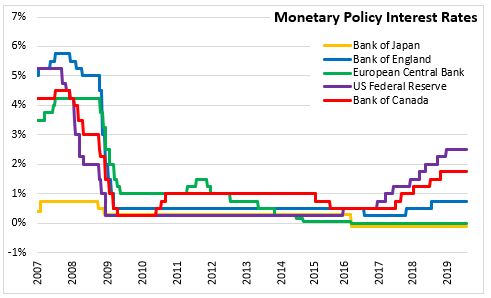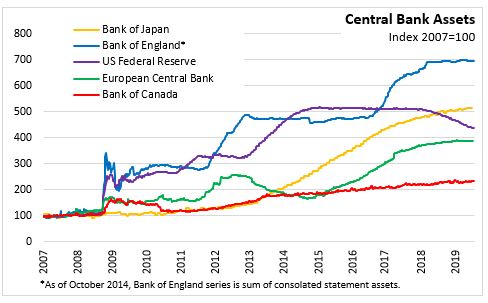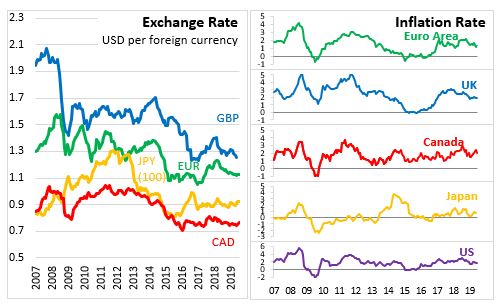The Economics and Statistics Division maintains archives of previous publications for accountability purposes, but makes no updates to keep these documents current with the latest data revisions from Statistics Canada. As a result, information in older documents may not be accurate. Please exercise caution when referring to older documents. For the latest information and historical data, please contact the individual listed to the right.
<--- Return to Archive
For additional information relating to this article, please contact:
July 30, 2019BANK OF JAPAN MONETARY POLICY The Policy Board of the Bank of Japan announced today that it will maintain the negative interest rate of -0.1 per cent on balances of financial institutions at the Bank. Furthermore, the Board will continue to maintain these interest rates for an extended period of time - at least until the Spring of 2020. The Bank will continue its purchases of Japanese Government Bonds in order to keep 10-year yields at around zero per cent. These bond purchases will be flexible, with amounts outstanding rising by about 80 trillion yen per year. The Bank will continue purchasing exchange-traded funds at 6 trillion yen per year and real estate investment trusts at 90 billion yen per year. Commercial paper (2.2 trillion yen) and corporate bond (3.2 trillion yen) holdings by the Bank will be maintained.
The Bank of Japan is continuing with its policy of "Quantitative and Qualitative Monetary Easing (QQE) with Yield Curve Control", with the aim to achieve price stability target of 2 per cent, as long as is necessary for maintaining the target in stable manner. The monetary base will continue to expand until the year-on-year rate of increase in the consumer price index (CPI, all items less fresh food) exceeds 2 per cent and stays above the target in stable manner. The Bank of Japan noted that if downside risks in overseas economies develop, they would not hesitate to pursue additional easing measures if the momentum towards the price stability target would be lost.
Japan’s economy has experienced a virtuous cycle from income to spending, but production and business sentiment have been affected by slowdown in other economies. Steady improvement has been made in employment and incomes. Housing and public investment have been relatively flat and labour market conditions remain tight in the country.
Japan's economy is expected to continue to expand through the fiscal 2021 year despite slowing in overseas economies. Exports will show only a moderate increasing trend, but domestic demand will follow an upward trend on back of highly accommodative financial conditions and government spending. The employment and income situation are expected to continue to improve and drive private consumption. The scheduled consumption tax hike in October 2019 will likely frontload consumer demand and be a drag on consumption for some time afterwards. Public investment is likely to increase with Olympic Game related demand and natural disaster response and preparedness. Business fixed investment, mostly for domestic capacity expansion, will expand with the economy in areas related to productivity and urban redevelopment. The economy is projected to grow in line with potential on average over the forecast period. The Bank of Japan median real GDP growth rate projection for are mostly unchanged compared to their previous estimates at 0.7 per cent in fiscal 2019, 0.9 for fiscal 2020 and 1.1 per cent for fiscal 2021.
Consumer inflation has been positive but relatively slow given the ongoing economic expansion and tight labour market conditions. The Bank of Japan notes that firms continue to be cautious with wage and price setting. Households remain cautious towards price increases and have not clearly changed mindset and behaviour. Firms absorbing costs through productivity, recent technological progress and the high wage elasticity of labour supply are also contributing factors to mild inflation pressures; these issues will take time to resolve. The CPI is expected to increase gradually towards 2 per cent, primarily due to the output gap remaining positive and long-term inflation expectations rising. The CPI projections are mostly unchanged compared to previous estimates at 1.0 per cent in fiscal 2019, 1.3 per cent in fiscal 2020 and 1.6 per cent in fiscal 2021.



Source: Bank of Japan's Statement on Monetary Policy
<--- Return to Archive